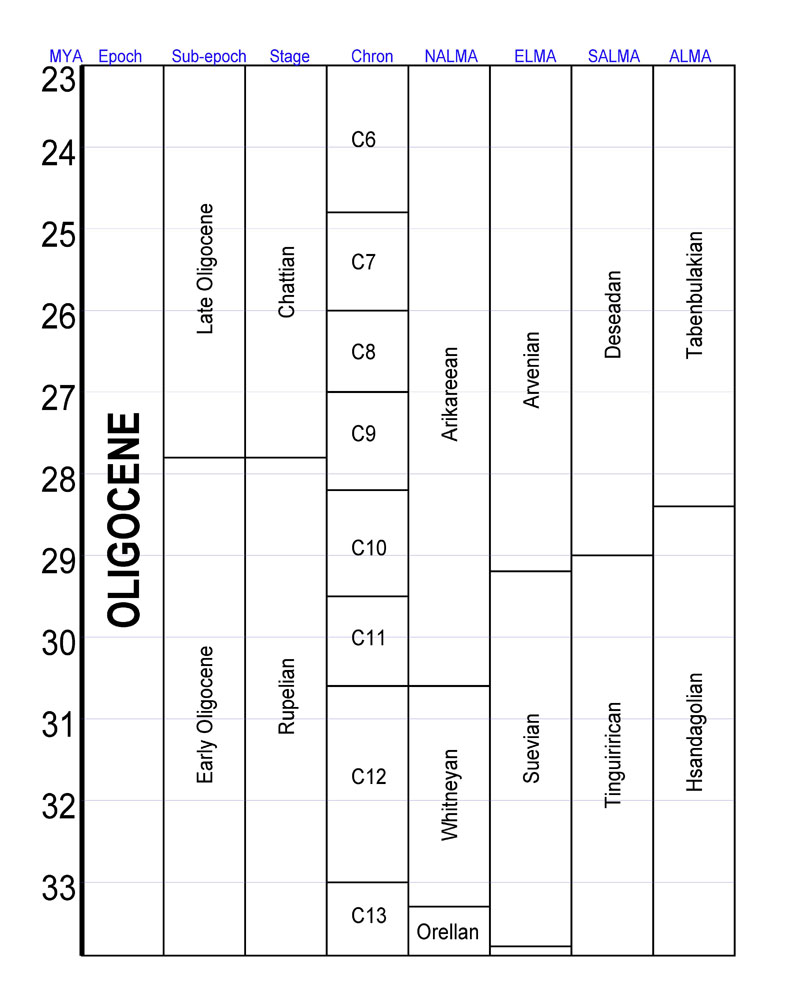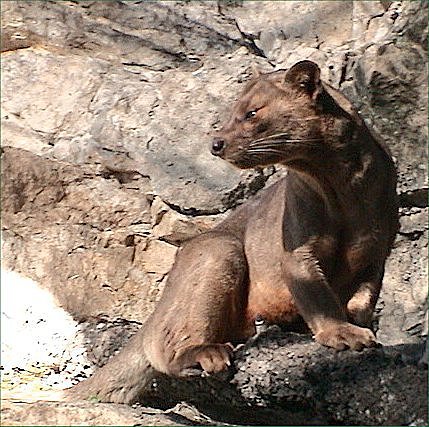|
Dinailurictis
''Dinailurictis'' was an extinct nimravid carnivoran (or "false sabre-toothed cat") belonging to the subfamily Nimravinae. It was named in 1922, with subsequent material being recovered from Early to Late Oligocene deposits across France and Spain. Taxonomy There is only one known species classified within the genus, ''Dinailurictis bonali''. Initial remains from La Tuque, France consisted of a left, upper canine noticeably larger than '' Eofelis'', '' Nimravus'', and ''Eusmilus''. Subsequent remains consisting of limb bones and additional teeth have since been found. ''Dinailurictis'' does resemble and was related to '' Nimravus'' as members of the Nimravinae subfamily, but do the two genera differ in several anatomical traits. Skeletal morphology aligns ''Dinailurictis'' closer with the somewhat larger genus, '' Quercylurus''. Systematic review conducted in 2003 found ''Quercylus major'' and ''Dinailurictis bonali'' to be extremely similar to one another, with the larger si ... [...More Info...] [...Related Items...] OR: [Wikipedia] [Google] [Baidu] |
Quercylurus
''Quercylurus'' is an extinct nimravid carnivora (or "false sabre-toothed cat") from the Early to Late Oligocene of France and Spain. Its fossils were found in Early Oligocene strata in Quercy. It is known with only one species ''Quercylurus major''. ''Q. major'' was possibly the largest nimravid ever known, as its fossils suggest it was similar in size to the modern-day lion. Currently there is only one described species within this genus, the type species, ''Q. major''. ''Q. major'' lived in the moist and humid forests of Oligocene Europe, alongside the much smaller, fellow nimravid '' Eofelis''. Taxonomy ''Quercylurus'' was named by Ginsburg (1979), and initially assigned to Felidae by Carroll in 1988. It would be placed as a member of Nimravidae, within the subfamily Nimravinae. ''Quercylurus'' was at one point classified as '' Nimravus intermedius major'', and then classed within the ''Dinailurictis'' genus. More recent research typically places ''Quercylurus'', ''Dinailur ... [...More Info...] [...Related Items...] OR: [Wikipedia] [Google] [Baidu] |
Nimravidae
Nimravidae is an extinct family (biology), family of carnivorans, sometimes known as false saber-toothed cats, whose fossils are found in North America and Eurasia. Not considered to belong to the true cats (family Felidae), the nimravids are generally considered closely related and classified as a distinct family in the suborder Feliformia. Fossils have been dated from the Middle Eocene through the Late Oligocene epochs (Bartonian through Chattian stages, 41.03–25.9 million years ago), spanning about . The barbourofelids, which were formerly classified as a subfamily of the Nimravidae, were reassigned to their own distinct family Barbourofelidae in 2004. However in the 2020s, some studies suggest the barbourofelids are a branch of the nimravids, suggesting that this debate might not be settled yet. If accepted, the family would have persisted until the Late Miocene, and would extend their spatial distribution to Africa. Taxonomy The family Nimravidae was named by American pale ... [...More Info...] [...Related Items...] OR: [Wikipedia] [Google] [Baidu] |
Quercy Phosphorites Formation
The Quercy Phosphorites Formation (French language, French: ''Phosphorites du Quercy''; ) is a Formation (geology), geologic formation and lagerstätte in Occitania (administrative region), Occitanie, southern France. It preserves fossils dated to the Paleogene Period (geology), period (Bartonian, latest Bartonian to Late Oligocene),Quercy Phosphorites Formation at Fossilworks.orgPhosphorites du Quercy Formation at Fossilworks.org or MP16 to MP28 zones of the Eu ... [...More Info...] [...Related Items...] OR: [Wikipedia] [Google] [Baidu] |
Eusmilus
''Eusmilus'' ('true sabre') is a prehistoric genus of Nimravidae, nimravid that lived in Europe and North America during the Late Eocene to Early Oligocene epochs (34.7–29.5 Annum, mya). Taxonomy There are three valid species of ''Eusmilus'', ''E. bidentatus'' and ''E. villebramarensis''. ''Ekgmoiteptecela'' MacDonald, 1963 was synonymized with ''Eusmilus'' by some authors, but is actually synonymous with ''Hoplophoneus''. The third species, ''E. adelos'', was described in 2021, and stands as the largest species in the genus. One study performed in 2016 moved all North American species to ''Hoplophoneus''. The discovery of ''E. adelos'' meanwhile, suggests that nimravids went along derived evolutionary pathways; conical-toothed, dirk-toothed, and scimitar-toothed, with and that their evolutionary paths split in two, leading to saber-toothed and conical-tooth forms that convergently evolved with those of true felids tens of millions of years later. Its discovery also sugg ... [...More Info...] [...Related Items...] OR: [Wikipedia] [Google] [Baidu] |
Nimravinae
The Nimravinae are a subfamily of the Nimravidae, an extinct family of feliform mammalian carnivores sometimes known as false saber-toothed cats. They were found in North America, Europe, and Asia from the Middle Eocene through the Late Oligocene epochs (Bartonian through Chattian stages, 40.4—23.03 mya), spanning about . Centered in North America, the radiation of the Nimravinae from the Eocene to Oligocene The Oligocene ( ) is a geologic epoch (geology), epoch of the Paleogene Geologic time scale, Period that extends from about 33.9 million to 23 million years before the present ( to ). As with other older geologic periods, the rock beds that defin ... was the first radiation of cat-like carnivorans. References {{Taxonbar, from=Q11884539 Nimravidae Bartonian first appearances Tortonian extinctions Taxa named by Edward Drinker Cope ... [...More Info...] [...Related Items...] OR: [Wikipedia] [Google] [Baidu] |
Paleogene France
The Paleogene Period ( ; British English, also spelled Palaeogene or Palæogene) is a geologic period, geologic period and system that spans 43 million years from the end of the Cretaceous Period Megaannum, Ma (million years ago) to the beginning of the Neogene Period Ma. It is the first period of the Cenozoic Era, the tenth period of the Phanerozoic and is divided into the Paleocene, Eocene, and Oligocene epochs. The earlier term Tertiary (period), Tertiary Period was used to define the time now covered by the Paleogene Period and subsequent Neogene Period; despite no longer being recognized as a formal stratigraphy, stratigraphic term, "Tertiary" still sometimes remains in informal use. Paleogene is often abbreviated "Pg", although the United States Geological Survey uses the abbreviation "" for the Paleogene on the Survey's geologic maps. Much of the world's modern vertebrate diversity originated in a rapid surge of diversification in the early Paleogene, as survivors of the ... [...More Info...] [...Related Items...] OR: [Wikipedia] [Google] [Baidu] |
Oligocene Mammals Of Europe
The Oligocene ( ) is a geologic epoch of the Paleogene Period that extends from about 33.9 million to 23 million years before the present ( to ). As with other older geologic periods, the rock beds that define the epoch are well identified but the exact dates of the start and end of the epoch are slightly uncertain. The name Oligocene was coined in 1854 by the German paleontologist Heinrich Ernst Beyrich from his studies of marine beds in Belgium and Germany. The name comes from Ancient Greek (''olígos'') 'few' and (''kainós'') 'new', and refers to the sparsity of extant forms of molluscs. The Oligocene is preceded by the Eocene Epoch and is followed by the Miocene Epoch. The Oligocene is the third and final epoch of the Paleogene Period. The Oligocene is often considered an important time of transition, a link between the archaic world of the tropical Eocene and the more modern ecosystems of the Miocene. Major changes during the Oligocene included a global expansion of gra ... [...More Info...] [...Related Items...] OR: [Wikipedia] [Google] [Baidu] |
Lophiomeryx
''Lophiomeryx'' is an extinct genus of lophiomerycid artiodactyl that lived in Eurasia during the Palaeogene and Neogene periods. Distribution The species ''L. shinaoensis'', ''L. gracilis'', and ''L. triangularis'' are known from the Early Oligocene of Mongolia Mongolia is a landlocked country in East Asia, bordered by Russia to the north and China to the south and southeast. It covers an area of , with a population of 3.5 million, making it the world's List of countries and dependencies by po .... References Prehistoric Artiodactyla genera Fossils of Mongolia Oligocene mammals of Asia Fossil taxa described in 1853 Tragulina {{paleo-eventoedungulate-stub ... [...More Info...] [...Related Items...] OR: [Wikipedia] [Google] [Baidu] |
Anthracotherium
''Anthracotherium'', from Ancient Greek ἄνθραξ (''ánthrax''), meaning "coal", and θηρίον (''theríon''), meaning "beast", is an extinct genus of artiodactyls characterized by having 44 teeth, with five semi-crescentic cusps on the crowns of the upper molars. The genus ranged from the middle Eocene period until the early Miocene, having a distribution throughout Eurasia probably even reaching South East Asia (Kalimantan and West Timor). Material subjectively assigned to ''Anthracotherium'' from Pakistan suggests the last species died out soon after the start of the Miocene. Description The genus typifies the family Anthracotheriidae, if only because it is the most thoroughly studied. In many respects, especially the anatomy of the lower jaw, ''Anthracotherium'', as with the other members of the family, is allied to the hippopotamus, of which it is probably an ancestral form. The Anthracotheres, together with the hippos, are grouped with the cetaceans in the clade W ... [...More Info...] [...Related Items...] OR: [Wikipedia] [Google] [Baidu] |
Anthracotheriinae
The anthracotheriines are an extinct subfamily of anthracotheres that comprised Paleogene to early Neogene North American and Eurasian artiodactyls. The group contained the genera ''Anthracotherium'', '' Heptacodon'', and '' Paenanthracotherium'', as well as possibly '' Myaingtherium'' and '' Siamotherium''. They were small to large sized anthracotheres, and when compared to the other two subfamilies, Microbunodontinae and Bothriodontinae The bothriodontines are a paraphyletic assemblage of anthracotheres that originated from Eurasia in the late middle Eocene (Bartonian). The group can be distinguished from other anthracothere lineages by their upper molars having a mesostyle oc ..., anthracotheriines are found to occupy a primitive, basal position in the family. References Anthracotheres Mammal subfamilies Eocene first appearances {{paleo-eventoedungulate-stub ... [...More Info...] [...Related Items...] OR: [Wikipedia] [Google] [Baidu] |
Feliformia
Feliformia is a suborder within the order Carnivora consisting of "cat-like" carnivorans, including Felidae, cats (large and small), hyenas, mongooses, viverrids, and related taxa. Feliformia stands in contrast to the other suborder of Carnivora, Caniformia consisting of "dog-like" carnivorans (includes Canoidea). The separation of the Carnivora into the broad groups of feliforms and caniforms is widely accepted, as is the definition of Feliformia and Caniformia as suborders (sometimes superfamilies). The classification of feliforms as part of the Feliformia suborder or under separate groupings continues to evolve. Systematic classifications dealing with only extant taxa include all feliforms into the Feliformia suborder, though variations exist in the definition and grouping of families and genera.Taxonomic references - extant species (1): Supporting descriptive information and picturesDiversity Web (online) – Feliformia/ref>Taxonomic references - extant species (2)Integrated ... [...More Info...] [...Related Items...] OR: [Wikipedia] [Google] [Baidu] |



